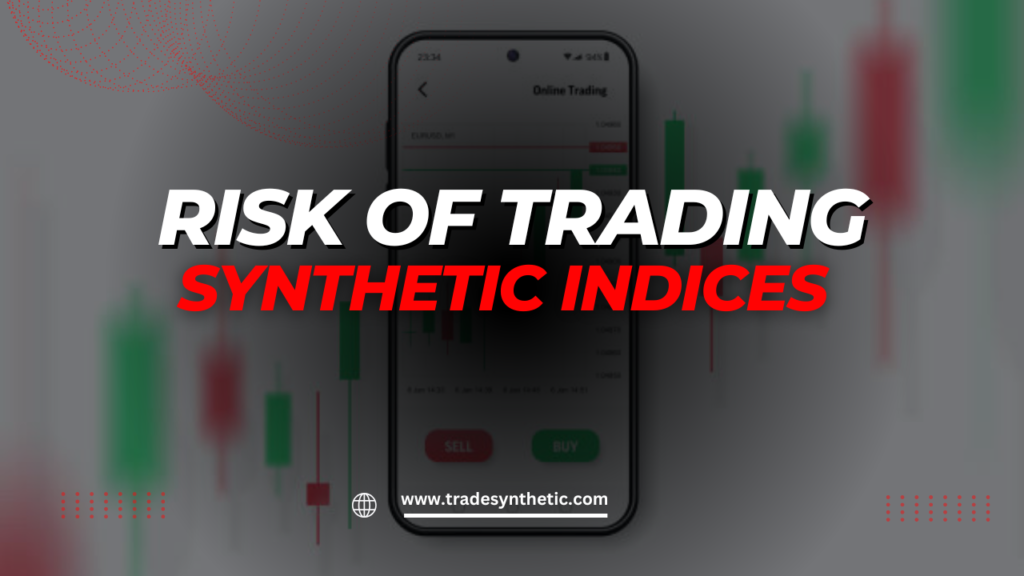Even though Synthetic indices trading has gained popularity due to its accessibility and unique features, it is not without risks. Just like any financial market, trading synthetic indices requires careful planning, understanding, and risk management.
In this article, we will discuss the risks of trading synthetic indices, how to identify these risks, and strategies to minimize them. If you’re new to synthetic indices or looking to refine your approach, understanding these risks is essential for long-term success.
What is Synthetic Indices Trading?
Synthetic indices are virtual trading instruments that simulate market behaviors, offering traders opportunities to profit. However, their unique nature also presents certain challenges that traders must be aware of.
1. High Volatility and Rapid Price Movements
One of the biggest risks associated with synthetic indices trading is the high level of volatility. Even experienced traders can find it difficult to predict price movements accurately, leading to significant losses if risk management strategies are not in place.
What does volatility mean?
Volatility refers to the rapid price fluctuations in the market. While it provides trading opportunities, it also increases the risk of losses. Synthetic indices like Volatility 75 Index are designed to mimic fast-moving markets, which can be challenging for traders, especially beginners.
2. Leverage and Margin Risks
Leverage is a double-edged sword in synthetic indices trading.
- How leverage works: Leverage allows traders to open large positions with a small amount of capital. While it amplifies profits, it also magnifies losses.
- Margin calls: If the market moves against your position, you might receive a margin call, requiring you to deposit additional funds to keep your trade open.
Using excessive leverage without understanding its impact can result in losing your entire trading account. Always use leverage cautiously and avoid overexposing yourself to the market.
3. Overtrading Due to 24/7 Availability
Synthetic indices are available for trading 24/7, which can be both an advantage and a risk.
- What is overtrading? Overtrading happens when traders take too many positions, often out of impulse or greed, leading to poor decision-making.
- Emotional fatigue: The round-the-clock availability of synthetic indices can tempt traders to stay glued to their screens, leading to exhaustion and emotional trading.
Overtrading can drain your capital and diminish your focus. It’s crucial to set trading limits and stick to your strategy to avoid unnecessary losses.
4. Lack of Fundamental Analysis
Unlike forex or stock markets, synthetic indices are not influenced by real-world events. While this can be an advantage, it also removes a critical analysis tool.
Why this is a risk?
In traditional markets, traders can use economic reports, news, and geopolitical events to predict price movements. Synthetic indices rely solely on technical analysis, which may not suit all trading styles.
Traders who excel in fundamental analysis may find it challenging to adapt to synthetic indices, as they need to rely entirely on chart patterns and indicators.
For beginners, the absence of fundamental data may lead to over-reliance on untested strategies, increasing the risk of loss.
5. Emotional and Psychological Risks
Trading synthetic indices can be mentally and emotionally draining, particularly for those who are unprepared.
- Fear and greed: These emotions are common in trading and can lead to impulsive decisions, such as closing profitable trades too early or holding onto losing trades for too long.
- Pressure to recover losses: Losing money can trigger revenge trading, where traders try to win back their losses quickly, often leading to further losses.
Managing emotions and maintaining discipline are key to overcoming these psychological challenges in synthetic indices trading.
6. Limited Regulation and Transparency
Synthetic indices are typically offered by specialized brokers, and the lack of regulation in some regions poses risks.
Traders may worry about the reliability of the platform and the fairness of market conditions. If a broker operates in an unregulated environment, traders may face difficulties recovering their funds in case of disputes.
It’s important to choose a broker that is transparent and adheres to strict standards of fairness, such as using audited random number generators for synthetic indices.
7. Misunderstanding the Market Structure
Many beginners enter synthetic indices trading without fully understanding how these markets work.
- Common mistakes: New traders often misinterpret price charts or fail to grasp the concept of probability, leading to poor decisions.
- Overconfidence: A few successful trades can create a false sense of security, encouraging risky behavior.
Education and practice are essential to build a solid foundation and avoid costly mistakes in synthetic indices trading.
Strategies to Manage Risks
To succeed in synthetic indices trading, you must actively manage risks. Here are some practical strategies:
- Use a demo account
This is simply practice trading with virtual funds before risking real money.
- Set stop-loss and take-profit orders
These tools help limit your losses and secure profits.
- Manage leverage wisely
Avoid using excessive leverage, especially if you’re new to trading.
- Stick to a trading plan
Develop a clear strategy and avoid making impulsive decisions.
- Take breaks
Step away from trading when you feel overwhelmed to maintain focus and clarity.
Conclusion
In all the amazing opportunities that Synthetic Indices Trading offers, they also come with significant risks. You have seen how high volatility, leverage, emotional challenges, and the lack of fundamental analysis are some of the common risks traders face.
To succeed, it is essential to understand these risks, use effective risk management strategies, and trade with discipline.
By choosing a reliable broker, practicing on a demo account, and sticking to a well-defined trading plan, you can navigate the challenges of synthetic indices trading and improve your chances of success.
Frequently Asked Questions
What are synthetic indices?
- Synthetic indices are virtual trading instruments that simulate real market behaviors without being influenced by external factors like news or economic data.
Are synthetic indices risky?
- Yes, synthetic indices come with risks such as high volatility, leverage, overtrading, and emotional challenges. Proper risk management is crucial to minimize these risks.
How can I manage risks in synthetic indices trading?
- You can manage risks by using stop-loss orders, practicing on demo accounts, avoiding overtrading, and managing leverage carefully.
Are synthetic indices regulated?
- The regulation of synthetic indices depends on the broker offering them. It’s important to trade with a broker that ensures transparency and fairness.
Can beginners trade synthetic indices?
- Yes, beginners can trade synthetic indices, but they should start with a demo account and learn about risk management before trading with real money.










